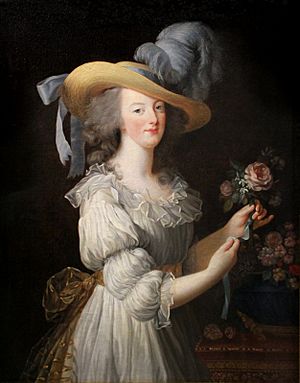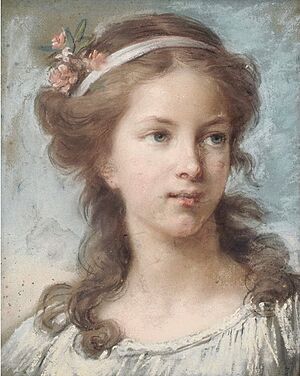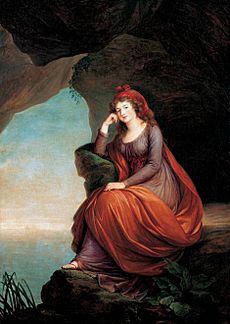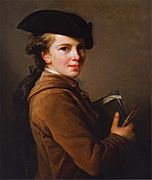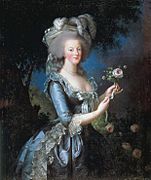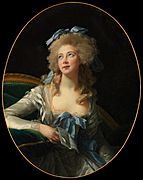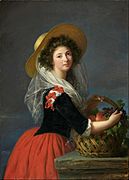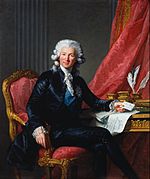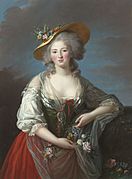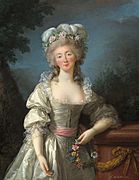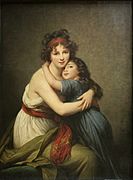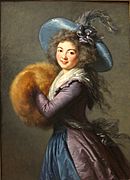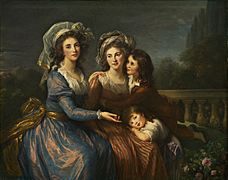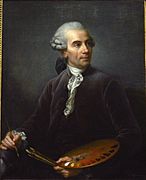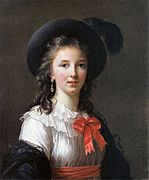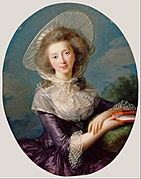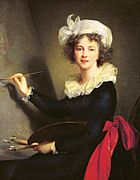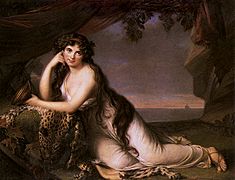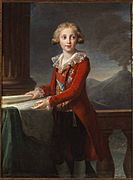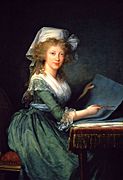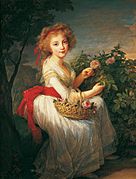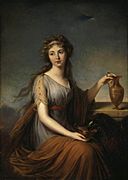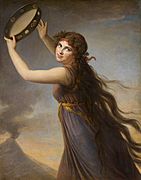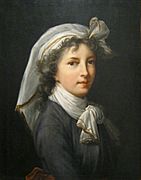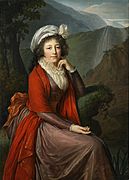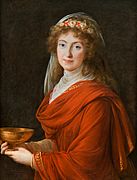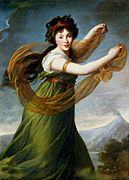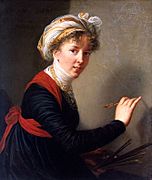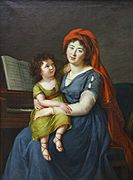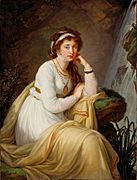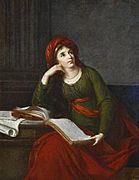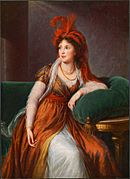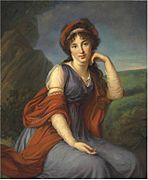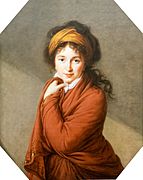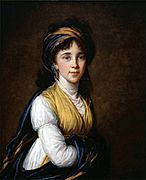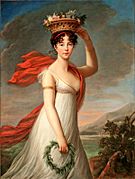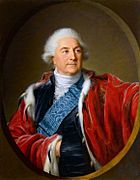Élisabeth Vigée Le Brun facts for kids
Quick facts for kids
Élisabeth Vigée Le Brun
|
|
|---|---|
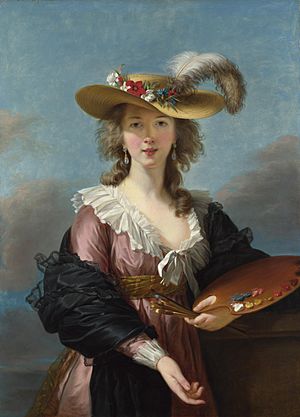
Self-portrait in a Straw Hat, 1782
|
|
| Born |
Élisabeth Louise Vigée
16 April 1755 |
| Died | 30 March 1842 (aged 86) Paris, France
|
| Nationality | French |
|
Notable work
|
Marie Antoinette with a Rose, Marie Antoinette en gaule |
| Movement | Rococo |
Élisabeth Louise Vigée Le Brun (16 April 1755 – 30 March 1842) was a famous French portrait painter. She was also known as Madame Le Brun. She painted many portraits, especially of women, in the late 1700s and early 1800s.
Her art style mixed Rococo and Neoclassicism. She used Rococo colors and subjects. But her painting style was more like the new Neoclassicism. Vigée Le Brun became well-known by painting Marie Antoinette, the Queen of France. Many rich people, actors, and writers hired her. She was even chosen to join art academies in ten different cities. Famous artists like Joshua Reynolds thought she was one of the best portrait painters of her time. They compared her to the old Dutch masters.
Vigée Le Brun painted 660 portraits and 200 landscapes. Her paintings are in major museums around the world. These include the Louvre in Paris and the Metropolitan Museum of Art in New York. She was very sensitive to sounds, sights, and smells.
When she was in her 80s, Vigée Le Brun wrote her memories. These books, called Souvenirs, also gave advice to young portrait painters.
Contents
Biography
Early Life and Artistic Beginnings
Élisabeth Louise Vigée was born in Paris on April 16, 1755. Her mother, Jeanne, was a hairdresser. Her father, Louis Vigée, was a portrait painter. He was very happy about her artistic talent. He gave her her first art lessons.
In 1760, at age five, she went to a convent school. She stayed there until 1766. Her father died when she was 12. In 1768, her mother married a jeweler named Jacques-François Le Sèvre. The family then moved to a new home near the Palais Royal. Élisabeth also got advice from other famous painters like Jean-Baptiste Greuze. Their influence can be seen in her portrait of her younger brother, Étienne Vigée.
By her early teens, Élisabeth was painting portraits for money. She joined the Académie de Saint-Luc in 1774. On January 11, 1776, she married Jean-Baptiste-Pierre Le Brun. He was a painter and art dealer. Vigée Le Brun started showing her art at their home in Paris. The art shows she held helped her meet many important people. Her husband spent a lot of the money she earned from her paintings.
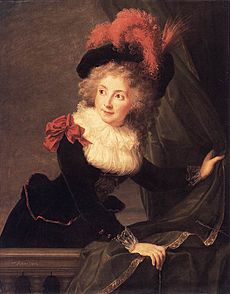
On February 12, 1780, Vigée Le Brun had a daughter. Her name was Jeanne Lucie Louise, but Élisabeth called her Julie.
In 1781, she and her husband traveled to Flanders and the Netherlands. Seeing the works of famous Flemish artists gave her new ideas. Her Self-portrait with Straw Hat (1782) was inspired by a painting by Peter Paul Rubens. Dutch and Flemish art also influenced her later works.
In 1787, one of her paintings caused a small stir. Her Self-portrait with Her Daughter Julie (1787) showed her smiling with her mouth open. This was unusual for portraits at the time. People were used to paintings where people had closed mouths.
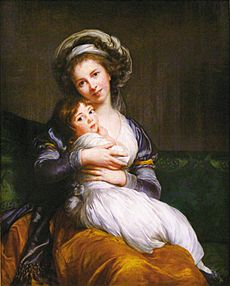
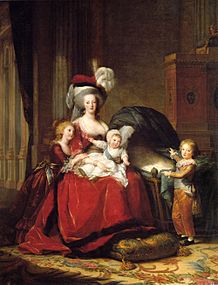
Painting for Marie Antoinette
As her career grew, Vigée Le Brun became a favorite painter of Marie Antoinette. She painted over 30 portraits of the queen and her family. This made many people think she was the queen's official painter.
In 1783, Vigée Le Brun showed a portrait of the queen. It was called Marie-Antoinette in a Muslin Dress. In this painting, the queen wore a simple, informal white cotton dress. This caused a scandal. People were upset by the casual clothing. Le Brun quickly removed the painting and made a new one. In the new portrait, the queen wore more formal clothes.
Vigée Le Brun's later painting, Marie Antoinette and Her Children (1787), tried to make the queen look better to the public. It showed the queen at home in the Palace of Versailles. She was shown as a mother with her children. This painting aimed to help people see Marie Antoinette in a more positive light. The child on the right points to an empty cradle. This showed that the queen had recently lost a child. It highlighted her role as a mother.
Joining the Royal Academy
On May 31, 1783, Vigée Le Brun became a member of the Académie royale de peinture et de sculpture. She was one of only 15 women to be full members between 1648 and 1793. Another female artist, Adélaïde Labille-Guiard, joined on the same day.
At first, Vigée Le Brun was not allowed to join. This was because her husband was an art dealer. But King Louis XVI stepped in. Marie Antoinette had asked him to help her favorite painter. So, the Academy had to accept her. For her entry piece, Vigée Le Brun painted an allegorical work. It was called Peace Bringing Back Abundance. This was not a portrait. Her membership in the Academy ended after the French Revolution. This was because female members were no longer allowed.
Life in Exile
As the French Revolution became more intense, Vigée Le Brun's home was bothered by angry crowds. She was linked to Marie Antoinette. She became very worried and her health suffered. Friends helped her leave Paris for a few days to recover.
The situation in Paris got worse. Vigée Le Brun decided to leave the city. She got passports for herself, her daughter, and their governess. The next day, guards told her not to leave. But two friendly guards later advised her to go quickly. She left Paris at midnight on October 5, 1789. She, her daughter, and governess dressed simply to avoid attention. She traveled to Lyon and then crossed the border. She was relieved to be out of France. Her husband stayed in Paris. He said she went to Italy to improve her art. But she was really afraid for her safety.
For 12 years, she lived and worked outside France. She stayed in Italy (1789–1792), Austria (1792–1795), Russia (1795–1801), and Germany (1801). She always remained loyal to the royal family.
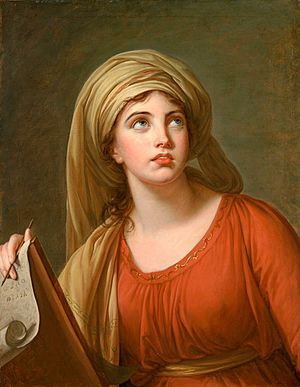
Italy
Vigée Le Brun arrived in Turin, Italy. She met famous artists there. She continued her journey south to Parma. While in Italy, she was chosen to join art academies in Parma (1789) and Rome (1790).
In Naples, she painted portraits of Maria Carolina of Austria, Marie Antoinette's sister. She also painted Maria Carolina's four oldest children. Vigée Le Brun also painted Emma, Lady Hamilton in different poses. Lady Hamilton was also the model for Vigée Le Brun's Sibyl (1792). This painting was inspired by older works of art. The Sibyl was Vigée Le Brun's favorite painting. She showed it in many cities, including Venice, Vienna, and Saint Petersburg. It was very successful and received much praise. Vigée Le Brun saw her Sibyl as a history painting. This was the highest type of painting in the Academy's rules. While in Italy, Vigée Le Brun visited many churches, galleries, and ancient ruins.
Austria
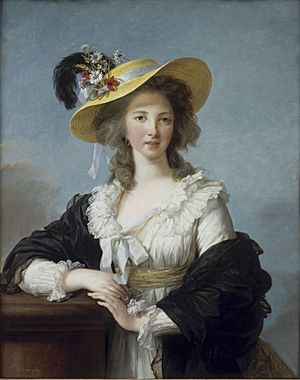
In Vienna, Vigée Le Brun painted portraits of Princess Maria Josepha Hermengilde Esterházy and Princess Karoline von Manderscheid-Blankenheim. These portraits showed the princesses in simple, Roman-style clothes. This showed the influence of Neoclassicism.
She also met her friend, the Charles-Joseph, 7th Prince of Ligne, again in Vienna. He encouraged her to visit Russia and meet Catherine the Great. Vigée Le Brun stayed at his former convent on Kahlenberg, which had a great view. After two and a half years in Vienna, she left for St. Petersburg in April 1795. On her way, she visited Dresden and the Königsberg fortress. In Dresden, she saw the famous Dresden gallery. She wrote that it was the largest in Europe. There, she saw Raphael's Madonna di San Sisto.
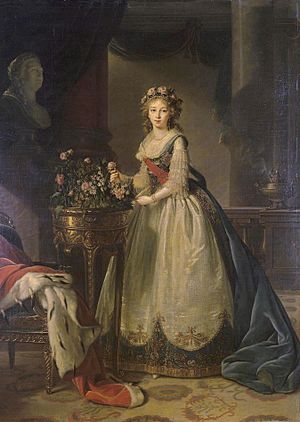
Russia
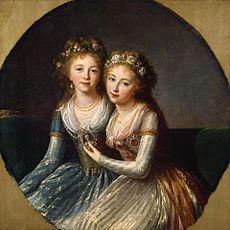
Vigée Le Brun stayed in Russia from 1795 to 1801. She was welcomed by the rich families there. She painted many nobles, including the former king of Poland, Stanisław August Poniatowski. She also painted Catherine the Great's granddaughters, Elena and Alexandra Pavlovna. She painted them in Greek-style tunics. Some people thought the dresses showed too much skin. Le Brun changed the dresses in the painting to have longer sleeves.
Catherine the Great herself agreed to pose for Le Brun. But she died the very next day. While in Russia, Vigée Le Brun became a member of the Academy of Fine Arts of Saint Petersburg.
Her daughter, Julie, married Gaétan Bernard Nigris. Vigée Le Brun was very upset by this marriage. She felt her daughter was being taken away from her. She eventually agreed to the wedding. But she found her time in Russia less enjoyable after that. She decided to return to Paris.
Before leaving Russia, Vigée Le Brun visited Moscow. On her way, she heard that Paul I had been killed. The journey was difficult because of melting snow and mud. She enjoyed her stay in Moscow and painted many portraits. When she returned to St. Petersburg, she met the new Emperor Alexander I and Empress Louise. They asked her to stay. But Vigée Le Brun was determined to leave Russia. She left after living there for six years. Julie died before her mother in 1819. They had made up by then.
Prussia
After leaving St. Petersburg, Le Brun traveled through Prussia. She visited Berlin. The Queen of Prussia invited Vigée Le Brun to Potsdam. The queen asked her to paint her portrait. The queen wanted her to stay in the Potsdam palace. But Vigée Le Brun chose to stay in a nearby hotel.
The queen and Vigée Le Brun became friends. The queen gave her a special bracelet. Vigée Le Brun treasured this gift for the rest of her life. She also visited the queen's Peacock Island. There, she enjoyed the countryside.
She painted other pastel portraits for Prince Ferdinand's family. While in Berlin, she met the ambassador Bournonville. He told her it was safe to return to France. Her brother and husband had already arranged for her to be removed from the list of people who had left France. Before she left Berlin, she was given a diploma. It made her a member of the Prussian Academy of Arts. After Berlin, she visited Dresden and Brunswick. She also passed through Weimar and Frankfurt.
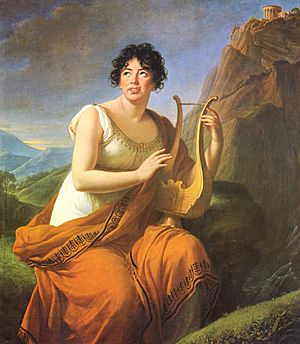
Return to France and Stay in Paris
After a long effort by her ex-husband and family, Vigée Le Brun was allowed to return to France. She came back in January 1802. She received a warm welcome in her Paris home. The press praised her return. She was also reinstated as a member of the Comédie-Française theater.
Soon after, she saw Napoleon Bonaparte for the first time. She saw him from a window in the Louvre. She found it hard to recognize him. She had imagined a taller person. A few days later, Bonaparte's brothers visited her gallery. They admired her famous Sibyl painting.
Vigée Le Brun was surprised by how much Parisian society had changed. She visited her old friend, the painter Joseph-Marie Vien. She also met her friend Princess Dolgorouky from St. Petersburg. Vigée Le Brun felt troubled in Paris. She remembered the early days of the revolution. So, she decided to move to a quiet house in Meudon forest. She was visited by friends there, which cheered her up. Soon after, Vigée Le Brun decided to travel to England. She left Paris on April 15, 1802.
England
Vigée Le Brun arrived in Dover, England. She took a stagecoach to London. She was with her future lifelong friend, Mme. Adélaïde. Vigée Le Brun was confused by the large crowds at the docks. She had heard about highwaymen in England. So, she hid her diamonds in her stocking. She was scared by two riders on her way to London, but nothing happened.
In London, she stayed at a hotel. She then moved to a house in Beck Street. She later moved to a beautiful house in Portman Square. But she had trouble with noise from neighbors. She finally settled in a damp building in Maddox Street. She was tired of moving. The dampness and London's humid weather made painting difficult.
Vigée Le Brun felt London lacked artistic inspiration. This was because there were few public art galleries then. She visited famous places like Westminster Abbey and St. Paul's Cathedral. She disliked how quiet London was on Sundays. All shops were closed, and there were no social gatherings. She also did not enjoy the English social parties, called "Routs." She found them stiff and dull.
She visited the studios of other artists, like Benjamin West. She also saw works by Joshua Reynolds. Vigée Le Brun was surprised that visitors to studios usually paid a small fee. She did not follow this custom. She was very happy to meet the famous actress Sarah Siddons. Siddons visited Vigée Le Brun's studio.
Vigée Le Brun continued to host parties at her house. Many important people visited her. These included the Prince of Wales and famous singer Giuseppina Grassini. Le Brun also sought out other French people living in England. She became friends with the Comte d'Artois and his son.
Soon after she arrived, fighting between France and the UK started again. The British government ordered most French people to leave. But the Prince of Wales made sure Vigée Le Brun could stay as long as she wanted. He even delivered the special permit to her himself.
Vigée Le Brun toured the English countryside. She visited Gilwell Hall and met the musician Giovanni Battista Viotti. She painted Mrs. Chinnery and her children there. She also visited Windsor Great Park and Hampton Court. She went to Bath, enjoying its architecture. She found some Russian friends there. She also visited the astronomers William Herschel and his sister Caroline Herschel.
She loved the English countryside. She described Matlock as beautiful as Switzerland. She visited the Duchess of Dorset at Knole House. She then returned to London. She visited Warwick Castle, which she had heard much about. She also visited Blenheim Palace. After nearly three years in England, she prepared to return to France.
Later Life

She traveled to Switzerland in 1807 and 1808. In Geneva, she became an honorary member of an art society. She stayed with Madame de Staël and painted her portrait. In her later years, Vigée Le Brun bought a house in Louveciennes, France. She split her time between Louveciennes and Paris. She died in Paris on March 30, 1842, at age 86. She was buried in the Cimetière de Louveciennes. Her tombstone says, "Here, at last, I rest..."
Exhibitions
During her life, Vigée Le Brun's art was shown in Paris at several places. These included the Académie de Saint-Luc (1774) and the Salon of the Académie (from 1783 to 1824).
The first big show of all her works was in 1982. It was held at the Kimbell Art Museum in Fort Worth, Texas. A major international show of her art opened in Paris in 2015. It then traveled to the Metropolitan Museum of Art in New York (2016) and the National Gallery of Canada in Ottawa (2016).
Gallery
Portraits painted in France
-
Étienne Vigée, 1773. Saint Louis Art Museum.
-
Marie Antoinette with a Rose, 1783. Palace of Versailles.
-
Madame Grand, 1783. Metropolitan Museum of Art.
-
Marie-Gabrielle de Gramont, Duchesse de Caderousse, 1784. Nelson-Atkins Museum of Art.
-
Charles-Alexandre de Calonne, 1784. Royal Collection.
-
Élisabeth of France, sister of Louis XVI. 1782, Musée de l'Histoire de France
-
Madame du Barry, 1782. This was one of three portraits the artist made of du Barry.
-
Comtesse de La Châtre, 1789. Metropolitan Museum of Art.
-
Self-portrait with Her Daughter, 1789. Louvre.
-
Madame Molé-Reymond, actrice de la Comédie italienne, 1786. Louvre Museum.
-
Portrait of Joseph Vernet, 1778. Louvre Museum.
-
Portrait of Hubert Robert, 1788. Exhibited in the 1779 Salon Carré. Louvre Museum.
-
Self-Portrait, 1781. Kimbell Art Museum.
-
Vicomtesse de Vaudreuil, 1785. Getty Center.
Portraits painted in Italy
-
Self-portrait, painting Marie Antoinette, 1790. Uffizi.
-
Francesco di Borbone, 1790. Museo di Capodimonte.
-
Luisa Maria Amelia di Borbone, 1790. Museo di Capodimonte.
-
Maria Cristina of Bourbon, 1790. Museo di Capodimonte.
-
Anne Pitt as Hebe, 1792. Hermitage Museum.
Portraits painted in Austria
-
La comtesse Maria Theresia Bucquoi, 1793. Minneapolis Institute of Art.
-
Theresa, Countess Kinsky, 1793. Norton Simon Museum.
Portraits painted in Russia
-
Self portrait of herself painting Louise of Baden submitted for her admission to the St. Petersburg Academy of Arts Now in the Hermitage Museum. Along with the other Uffizi portrait, are the only surviving self portraits by the artist showing her in the act of painting.
-
Princess Ekaterina Nikolaevna Menshikova, 1795. National Gallery of Armenia.
-
Anna Ivanovna Baryatinskaya Tolstoy, 1796. National Gallery of Canada.
-
Princess Ana Gruzinsky Galitzine, 1797. Baltimore Museum of Art.
-
Varvara Golovina, 1797–1800. Barber Institute of Fine Arts.
-
Anna Beloselskaya-Belozerskaya, 1798. National Museum of Women in the Arts.
-
Julie Le Brun as Flora, 1799. Museum of Fine Arts (St. Petersburg, Florida).
-
Stanislaus Augustus Poniatowski, former king of Poland, 1796. Versailles Collection.
See also
 In Spanish: Marie Louise Élisabeth Vigée Lebrun para niños
In Spanish: Marie Louise Élisabeth Vigée Lebrun para niños


